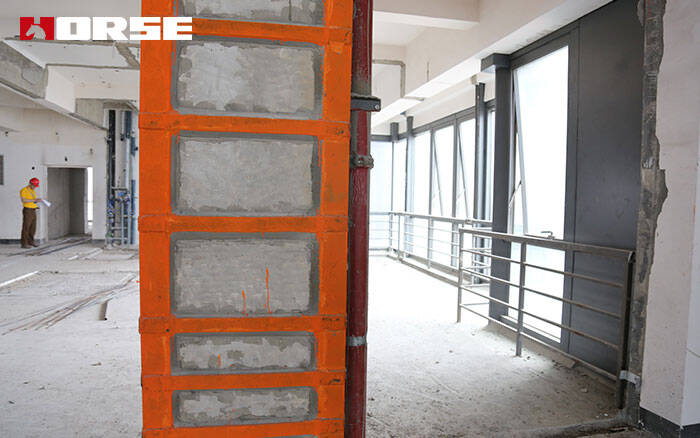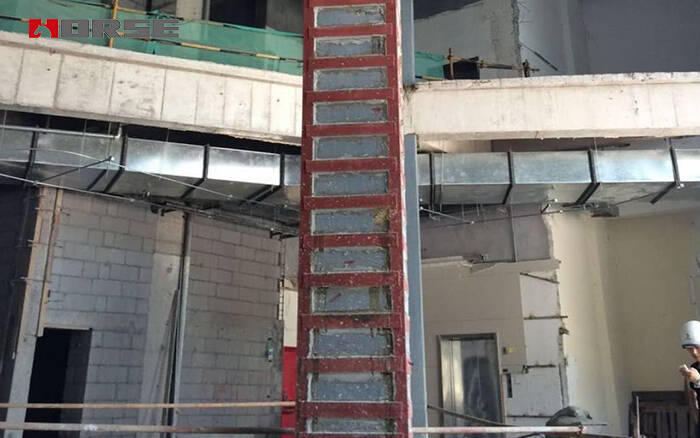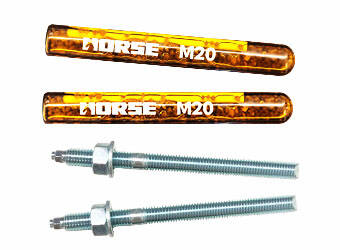Solutions
Horse Construction offers full range of structural strengthening materials with technical supports, documentation supports, products supports, project supports.
7 Common Problems In The Construction Of Steel Jacketing Glue

Hollowing problem
Reason:
1. Leaking glue due to inadequate sealing.
2. Improper position of the glue injection hole and vent hole, improper glue injection construction sequence.
3. The gap between the steel plate and the concrete is uneven, and the glue injection speed is too fast.
4. As the glue penetrates into the concrete, the glue layer at the top or corners is vacant.
Solution:
1. Ensure that there is no glue leakage around the steel plate, glue nozzle, and vent hole, and block the glue nozzle and vent hole in time.
2. The spacing between the injection holes and the exhaust holes should be determined according to the actual situation. Generally, the spacing should not exceed 100cm. The bottom end of the glued steel plate should be provided with a glue injection hole, and the highest position, edge, and corner positions should be equipped with an vent hole. After confirming that the vicinity of the vent hole has been filled with glue and uniformly discharged, the vent hole should be sealed Blocking. When injecting glue, follow the principle of from low to high, from one end to the other, avoid disorderly operation, and ensure that the glue is discharged from the adjacent glue nozzle and vent before changing the glue position.
3. Ensure that the gap between the steel plate and the concrete is even and consistent as much as possible; uniformly inject glue at low speed to ensure the penetration and flow time of glue.
4. Use low speed and slow injection construction; the glue injection hole and vent hole at the highest position should be filled with pressure for a period of time, and the glue should be filled in time when the glue position drops; the highest position or corner position must be set with vent holes.
Small glue flow, slow glue injection speed
Reason:
1. The pipeline is blocked or leaking.
2. The pressure of the high-pressure grouting machine is insufficient.
3. Poor quality of steel filling glue and too high viscosity.
Solution:
1. Check the grouting machine and glue injection tools to ensure that the pipeline is sealed and unblocked, to ensure that the pressure of the grouting machine is normal, and if there is a problem, it is repaired in time.
2. For long-term filling, use acetone to clean the glue filling machine and pipes at regular intervals.
3. The choice of low viscosity for the steel filling glue is beneficial to the later colloidal infusion and the filling degree of the glue. At the same time, the viscosity of the steel filling glue should be in the appropriate range, taking into account the mechanical properties and safety performance of the material.
Can steel glue be used instead of steel jacketing glue?
The answer is: No, because there are many differences between the two and they cannot be used instead.
1. The density is different: the steel filling glue is 1.1~1.2g/cm³, which is a liquid glue, and the viscose steel glue is 1.7~1.8g/cm³, which is a paste glue. The steel filling glue has better fluidity and is more suitable as a potting material. .
2. The construction process is different: the steel glue is firstly fixed to the steel plate, so that there is a gap of about 2~3mm between the steel frame and the original component, and the glue is injected between the steel plate and the concrete. Steel glue is to first coat the mixed rubber evenly on the surface of concrete or steel, then stick the steel plate and fix it with a steel frame.

How to control the dosage and avoid waste?
The width of the gap between the profiled steel frame and the concrete base material determines the thickness of the glue gap, which has a direct effect on the amount of steel glue. Under normal circumstances, the use of steel glue can be reduced by controlling the minimum thickness of the glue joint.
1. The amount of glue used in the plaque is firstly affected by the width of the gap between the angle steel and the concrete base material. In addition, welding is another important factor that affects the amount of steel glue poured into the board. If the welding is rough, the thickness of the welded part between the plaque and the angle steel will increase, resulting in an increase in the gap between the plaque and the concrete base material, and the amount of glue used when injecting glue will also increase.
2. The nature of the steel glue itself will also affect the amount of colloid. Due to the different densities, the quality of different steel glues under the same volume is also different. The low-density type with the same quality of steel glue is larger and more advantageous, which can save the cost.
Can the steel glue handle high and low temperature and humid environment?
Conventional steel potting glue cannot meet these conditions at the same time. For high temperature, low temperature, and humid environments, Horse has corresponding customized products:
What is the reserved gap between the steel and the base material?
According to "Code for Design of Reinforcement of Concrete Structures" GB 50367-2013, Article 8.3.4 stipulates: The thickness of the glue joint of the externally bonded steel should be controlled at 3~5mm. Locally, glue joints with a length of no more than 300mm and a thickness of no more than 8mm are allowed, but they shall not appear within the range of 600mm at the end of the angle steel.
What are the acceptance indicators of pouring glue?
According to Article 9.6 of "Code for Construction Quality Acceptance of Building Structure Reinforcement Engineering" GB 50550-2010:
1. Adhesive strength inspection. After pasting, it should be allowed to stand for 7 days under contact pressure. On-site inspection and conformity assessment shall be carried out immediately after the expiration date. For specific testing content, refer to Appendix U of "Code for Acceptance of Construction Quality of Building Structure Reinforcement Engineering" GB 50550-2010.
2. Detect the fullness of glue injection. Detect with instrument or percussion method, and the detection result shall be qualified if the hollow rate is not more than 5%. If the emptying rate exceeds the limit, drill holes should be drilled at the exact location, and the glue should be refilled through a syringe.
You can find anything here you are in need of, have a trust trying on these products, you will find the big difference after that.

High-strength anchor bolt with vinyl resin as main materials, composed of selected quartz sands, curing agents and glass tubes

Two-component epoxy modified epoxy structural strengthening adhesive for bonded steel plate to concrete

Modified epoxy resin structural perfusion adhesive, specifically for supporting adhesive bonded steel reinforcement